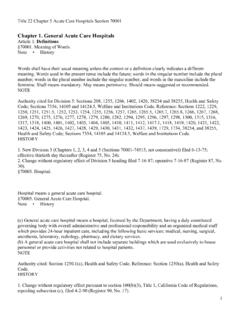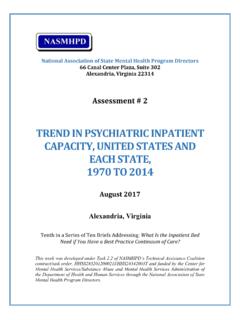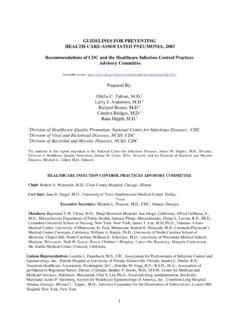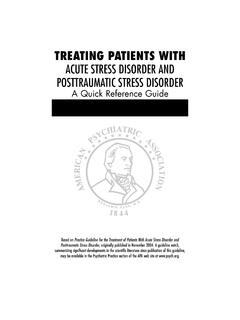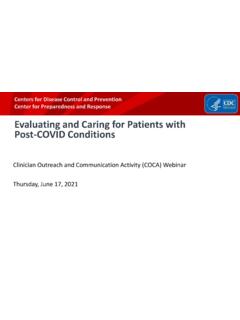Transcription of Post-Acute COVID-19 Syndrome (PACS)
1 Post-Acute COVID-19 Syndrome (PACS)Advisory Council to the DirectorDec 10, 2020 Walter J. Koroshetz, MDDirector, National Institute of Neurological Disorders and StrokeTRANS-NIHPOST- acute COVIDSEQUELAE TASK FORCEAMY PATTERSON /NHLBI Komal Arora, NHLBI Audie Atienza, NCATS Karin Bok, VRC Joseph Breen, NIAID Patti Brennan, NLM William Cefalu, NIDDK Stephen Chanock, NCI Sean Coady, NHLBI Richard Conroy, OD RosalyCorrea-De-Araujo, NIA Janelle Cortner, NCI Gaya Dowling, NIDA Robert Eisinger, NIAID Rachel Fleurence, OD Michelle Freund, NIDA Ken Gersing, NCATS David Goff, NHLBI Leanne Goldstein, OD, IMOD Susan Gregurik, OD, DPCPSI James Gulley, NCI Even Hadley, NIA Justin Hentges, OD, ALL Stephen Hewitt, NCI Keith Hoots, NHLBI Steve James, NIDDK Kathy Jung, NIAAA Bill Kapogiannis, NICHD Barbara Karp, NINDS Jim Kiley.
2 NHLBI Walter Koroshetz, NINDS Mike Kurilla, NCATS Andrea Lerner, NIAID Te r i Manolio, NHGRI Eliezer Masliah, NIA Amanda Melillo, NIDCR Sam Michael, NCATS Gina Montealegre, NIAID Lori Newman, NIAID Jenna Norton, NIDDK Luigi Notarangelo, NIAID Tessie October, NICHD April Oh, NCI Amy Patterson, NHLBI Eliseo Perez-Stable, NIMHD Lisa Postow, NHLBI Joni Rutter, NCATS Sheri Schully, OD, ALL Ivonne Schulman, NIDDK Christine Sizemore, FIC Mike Sneller, NIAID Rob Star, NIDDK Susan Sullivan, NIDCD Alastair Thomson, NHLBI Jackie Ward, NINDS Wendy Weber, NCCIH Andrew Weitz, NIBIB Carolyn Williams, NIAID Dana Wolff-Hughes, OD May Wong, NINDS21)Problem statement2)Clinical manifestations and knowledge gaps3)Leveraging our assets and strengths3 Post-Acute COVID-19 Syndrome4 Long-Term Effects of COVID-19 InfectionCOVID-19 Affects Multiple OrgansThe Scientist, April 20205 CLINICAL MANIFESTATIONS AND KNOWLEDGE GAPS6 COVID-19 : Persistent Symptoms in Hospitalized PatientsA Multi-Organ, Multi-System Clinical Presentation 120 patients (mean = 111 days post admission)Persistent symptoms Fatigue 55% Difficulty breathing 42% Memory loss 34% Sleep disorder 32% Attention disorder 27% Significant hair loss 20% Cough 17% Loss of smell 13% Chest pain 11% Loss of taste 11%Garrigues et al.
3 Infect. 2020 Aug 25:S0163-4453 patients (mean 60 days post onset) Carifi, et. al. JAMA. 2020;324(6):603-605. : Persistent Symptoms and Health-related Quality of Life1A Multi-Organ, Multi-System Clinical Presentation 120 patients (mean = 111 days after admission for COVID-19 )Professional and physical activities Not yet resumed to sports (engaged regularly pre-COVID) 28% Slower walking 29% Not yet returned to work (worked pre-COVID) 32%1 Letter to the Editor, Journal of Infection, Post-discharge persistent symptoms and health-related quality of life after hospitalization for COVID-19 , Eve Garrigues et symptomatic non hospitalized patients with positive test for SARS-CoV-2, 35% not returned to baseline health 2-3 weeks after testing Older age and comorbidities associated with lack of return to baseline health 19% of young adults (18-34)
4 With no comorbidities had not returned to baseline health In contrast 90% of influenza outpatients recover within 2 weeks9 New diagnoses of anxiety, insomnia, dementia, and mood disorders, as well as psychiatric disorders in general, were increased after COVID-19 Published online November 9, 2020 (20)30462-4 10 Cross-talk among injured organs might explain Post-Acute COVID syndrome11cMRIrevealed cardiac abnormalities in 78%, and gadolinium enhancement in 60%, (N-100), median 72d p dx. Independent of preexisting conditions, severity, and overall course of acute illness, and time from original diagnosis Lower EF, Higher LV volume, Higher hsTroponin 3 patients biopsied, demonstrate inflammatory infiltrates, no virus15% of Ohio State University athletes had myocarditis after mild COVID-19 , and fully half had CMR abnormalities12 Cardiac Involvement in COVID-19 Published Online: July 27,2020 common mechanisms between ischemic injury and COVID-19 induced cardiac remodeling; UnudurthiS.
5 Life Sciences 2020; 260: 118482 Autopsy reports suggest direct cardiac involvement Lindner showed virus in myocardiumin majority of 39 autopsy cases with evidence of viral replication: Direct viral infection leading to myocardial injury?? Other reports have also shown myocardium infiltration of both innate and adaptive immune cells: Potential for cardiac fibrosis and decrease cardiac function in the long term?? Conclusion: Long-term follow-up of recovered COVID-19 patients is necessary to assess risk of heart failure and other chronic CV complicationsJAMA Cardiol. Cardiol. : Long-term lung sequelae Carvalho-Schneider et al. followed 150 patients with non-critical COVID-19 for 2 months after symptoms onset Persistent dyspnea: pts at 30d, 30% pts at 60d Conclusion: A prolonged medical follow-up of patients with COVID-19 seems essential, whatever the initial clinical presentation (never admitted patients in this case) 2020 Zhao et al.
6 Analyzed 55 COVID-19 survivors (non-critical cases) 3 months after hospital discharge Radiological abnormalities: 71% pts Lung function abnormalities: 25% pts Elevated D-dimer on admission predictive of impaired DLCOat 3 months post-d/c (in some pts, only abnormality) Conclusion: It is necessary to follow up COVID-19 patients to appropriately manage persistent or emerging long-term 202014 Nervous System and COVID-19 Manifestations during infection Stroke-large & small vessel occlusion, micro-bleeds Confusion and depressed level of consciousness Loss of smell Muscle/Nerve pain and weakness Meningitis/encephalitis Seizures Asymptomatic hypoxiaRare Post-viral syndromes Delayed injury to brain and spinal cord (multiple sclerosis- like). Delayed injury to nerves (ie.)
7 Guillain Barre Syndrome ) Parkinsonism15 186 patients in 26 states, median age years 80% required ICU care, 20% required mechanical ventilation 71% with involvement of at least 4 organ systems 73% with no underlying conditions16 Health Disparities in COVID-19 Risk and MortalityBlack & Indigenous Americans experience highest death tolls from COVID-19 Cumulative actual COVID-19 mortality rates per 100,000, by race and ethnicity, April 13-Nov. 10, 2020 Note: All intervals are 14 days apart, except for 5/11-5/26, which is a 15-day period. 9/1, 9/29 and 10/27 data has been interpolated. Pacific Islander data prior to 10/13 did not include Hawaii, as it was not releasing data; its inclusion resulted in an overall drop in the Pacific Islander rate, which begins a new series at 10 : APM Research Lab.
8 Get the data. Created with Conditions Cancer Chronic Kidney Disease COPD Heart Conditions Obesity Pregnancy Sickle Cell Disease Smoking Type 2 we need to understand about recovery What is the spectrum of clinical recovery from COVID-19 infection? Of those with symptoms 2-3 weeks post infection the rate of improvement is not yet known. What interventions might enhance or hasten recovery? In the immediate post infection phase as well as in the more chronic phase What is the spectrum of tissue injury due to COVID-19 infection? Are the various tissue injuries reversible, static, or contribute to progressive organ dysfunction How to identify those with tissue injury in heart, lung, nervous system, kidney Will unabated symptoms lead to chronic illness(s) in a subset of people?
9 If so, what is its pathophysiology (s). Is so, what are the drivers of special vulnerability or resilience across the lifespan and in special populations Will COVID-19 infection predispose people to other diseases in the future?18 Preparing for the Possibility of a Post-COVID Storm Current expectation is that up to tens of thousands could suffer from sequelae of acute infection with COVID-19 Time is of the essence - interventions are expected to have a greater effect the earlier they are employed The multi-organ involvement calls for a coordinated research program drawing on the expertise in multiple NIH Institutes and Centers 19 LEVERAGING OUR ASSESTS AND STRENGTHSA Few Examples20 NIH Clinical Research Strategy toUnderstand and Treat Post-Acute Sequelae of COVID-19 Note.
10 Includes existing and new assetsEvaluation of Treatment and Preventive Strategies for Post-Acute COVID-19 SequelaeLongitudinal Community-Based Cohorts Large Scale EHR-/Health Systems-based Cohorts Longitudinal Deeply PhenotypedCommunity-based CohortsCase-based Registry Cohort of Persons with hx SARs COV-2 Infection Individuals Enrolled in NIH COVID-19 Clinical Trials Individuals Enrolled in NIH COVID-19 Case Registries/Observational Studies/ClinicsData Coordination/Harmonization and Analytics Framework21 NIAID: Observational Cohorts International Observational Study of Outpatients With SARS-CoV-2 Infection PREVAIL-XI: PREVAIL COVID-19 Observational Study Chasing COVID Cohort Immunophenotyping in a COVID-19 Cohort (IMPACC) Pediatric Research Immune Network on SARS-CoV-2 and MIS-C (PRISM) Observational study at San Antonio VA EHR based Corona infectious virus epidemiology team (CIVETs) Big Data Driven Clinical Informatics & Surveillance (BDD-CIS) project 22 Collaborative Cohort of Cohorts for COVID-19 Research (C4R) 70,000+ participants from 14+ longstanding longitudinal population-and disease-based cohorts Highly diverse with multi-racial, multi-ethnic populations Broad age range, national span of geographic reach Enriched for at-risk populations ( , pre-existing lung disease)
